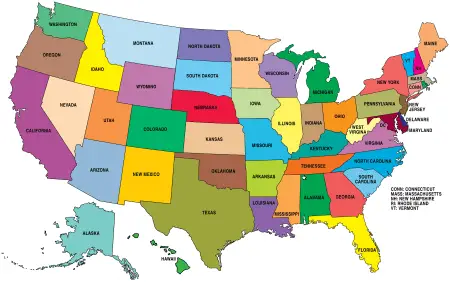Despite being closely related, a federation and a confederation are distinct political systems. This article aims to flesh out the differences between these inter-related systems.
Summary Table
| Federation | Confederation |
| An organization of sovereign states governed by a central power | An organization of sovereign and self-governing states |
| Membership is not voluntary | Membership is voluntary |
| Member states cannot easily leave the federation | Member states can break away from the confederation |
| Authority and power distributed as per the constitution | Confederate government has limited and weak powers |
Definitions

A federation (i.e. federal state) is a political organization composed of self-governing states or territories ruled by a central (federal) authority. In a federal system, power is divided between the central government and its member states, allowing the latter a degree of self-governance. This degree of autonomy, including the delegation of authority between the central government and its member states are usually mandated by the nation’s constitution. Thus, it is unconstitutional for any one party to break this mandate.
Member states do not usually deal with foreign policy in as much as they are not independently recognized by international law.
A federation is often established with an initial agreement between several independent states. This is accomplished to address their mutual problems, provide mutual defense, or to establish a nation.
The US currently holds the distinction of being the oldest continuing federation, and is seen as a role model of this political system
Federalism is the governmental structure in place in a federation. It is considered to be the opposite of a unitary state. Germany is a federation of 16 states. The USSR was once a federation of various Soviet republics and transitioned to a similar federal system when it became the Russian Federation. Countries such as Malaysia, India, and Nigeria became federations after gaining independence from the British Empire.

A confederation is a league of self-governing states that united for a common purpose or action. This confederation of states is usually formed by a treaty as a way of dealing with very important issues such as defense, economic relations, and foreign affairs. In this regard, the central government provides support for all its member states.
The relationship among member states of a confederation varies.
The same applies with how the member states interact with the governing body, including the distribution of authority among them. Some less strict confederations are similar to international organizations. On the other hand, confederations with stricter policies are closer to federal systems. Member states reserve the right to leave the confederation, as they still are a sovereign state.
Decisions created by the council representing the member states are not binding, or even subject to implementation by its members. Therefore, these policies are considered only as “agreements” rather than binding laws. Decision-making requires the consensus of all the member states, and not by a majority decision. This often results in slow and inefficient governance, which is the main reason confederates eventually transition into federalism.
Under the Articles of Confederation, the US was a confederate system from 1781 to 1789. The Swiss and German governments were former confederations that evolved into federations. The European Union (EU) is often considered by some as a confederation as the organization does not deal with foreign affairs, defense, and taxation.
Federation vs Confederation
So what’s the difference between a federation and a confederation? A federation is comprised of subordinate member states headed by a federal government.
In contrast, a confederation is a group of sovereign states united by common interests. A confederation is headed by a central governing body elected by the member states. In a federation, authority and power is lawfully divided between the federal government and its member states by its constitution.
Decision and policy-making need the consensus of ALL member states. Other than that, it does not wield any higher authority over the member states. Member states in a federation cannot easily break away from the federation, while confederate member states have the right to leave the group.





